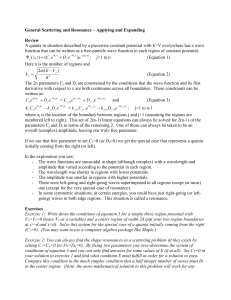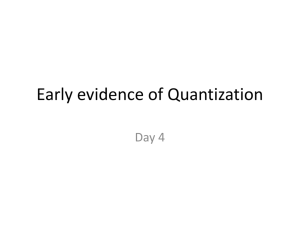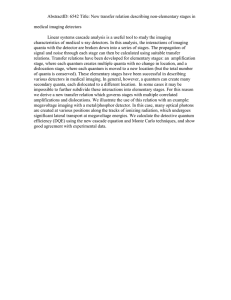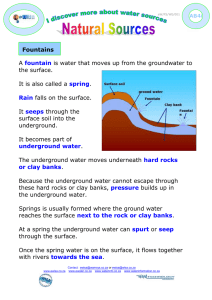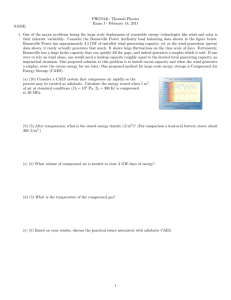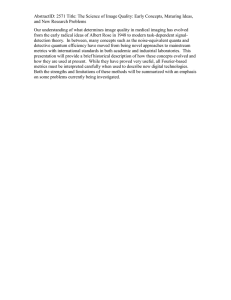Underground Power Distribution
advertisement
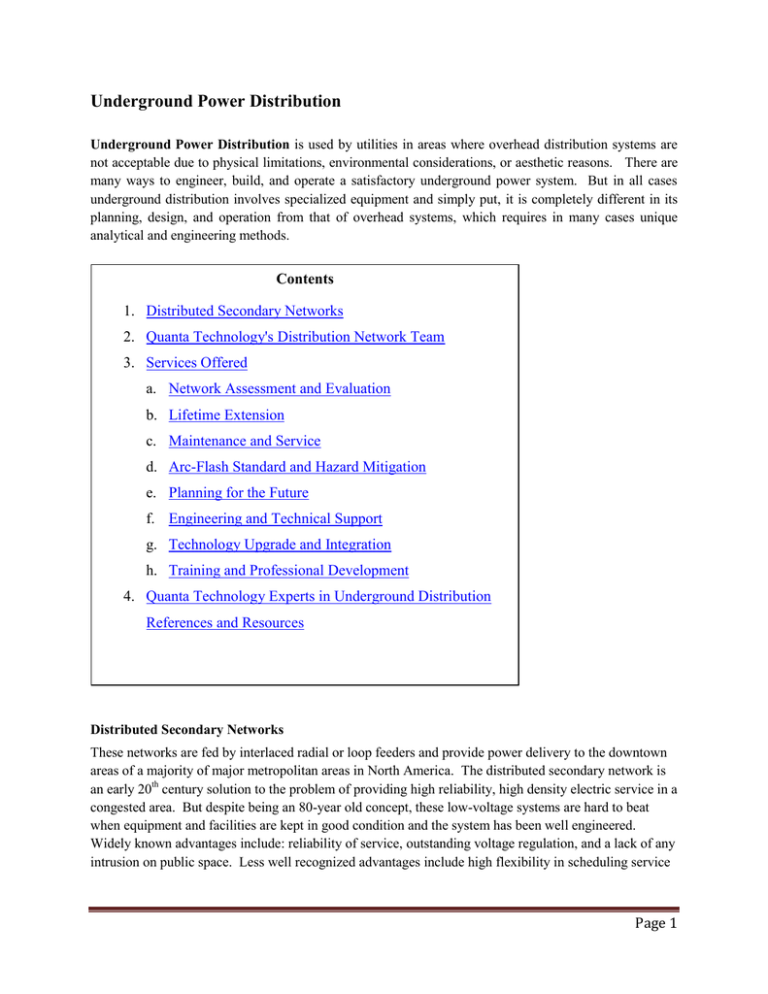
Underground Power Distribution Underground Power Distribution is used by utilities in areas where overhead distribution systems are not acceptable due to physical limitations, environmental considerations, or aesthetic reasons. There are many ways to engineer, build, and operate a satisfactory underground power system. But in all cases underground distribution involves specialized equipment and simply put, it is completely different in its planning, design, and operation from that of overhead systems, which requires in many cases unique analytical and engineering methods. Contents 1. Distributed Secondary Networks 2. Quanta Technology's Distribution Network Team 3. Services Offered a. Network Assessment and Evaluation b. Lifetime Extension c. Maintenance and Service d. Arc-Flash Standard and Hazard Mitigation e. Planning for the Future f. Engineering and Technical Support g. Technology Upgrade and Integration h. Training and Professional Development 4. Quanta Technology Experts in Underground Distribution References and Resources Distributed Secondary Networks These networks are fed by interlaced radial or loop feeders and provide power delivery to the downtown areas of a majority of major metropolitan areas in North America. The distributed secondary network is an early 20th century solution to the problem of providing high reliability, high density electric service in a congested area. But despite being an 80-year old concept, these low-voltage systems are hard to beat when equipment and facilities are kept in good condition and the system has been well engineered. Widely known advantages include: reliability of service, outstanding voltage regulation, and a lack of any intrusion on public space. Less well recognized advantages include high flexibility in scheduling service Page 1 and maintenance work and an extremely low marginal cost to absorb small amounts of load growth, making short-range planning for them quite easy. Among the disadvantages are initial cost – these are among the more expensive power distribution systems in terms of capital cost. Engineering and protection are complicated and far different than those of normal power systems, requiring technical skills not widely available in the industry. An industrywide shortage of engineers familiar with and qualified to work on networks means that many utilities no longer fine-tune their networks to take full advantage of all their inherent network capabilities. Instead they simply “get by” at a satisfactory operating level somewhat below their full potential. The flip side of the short-range planning ease is that long-range planning is particularly involved, with the long-term marginal cost of network growth being quite high at times and solutions being highly combinatorial and difficult to sort out using common analytical approaches. Again, specialized techniques are needed, methods not widely understood in the industry. Underground distributed networks require specialized protective equipment (network protectors and fast fuses) and call for intricately coordinated protection schemes, again using methods unique to these systems. Further, any large network will have high fault levels in places; sufficient to create concerns about arc-flash hazards, particularly with regards new standards and fire codes. But by far, the factor causing the biggest concern is aging infrastructures. Most downtown distributed networks in North American date from the pre- or post-WWII eras. Much of their electrical equipment has been replaced over the past 60 to 70 years but large portions remain quite old originals. Still, electrical equipment is relatively straightforward to replace, even if the expense is often a serious concern. The most worrisome aspects are the civil facilities – vaults, ducts, manholes, etc. Concrete, brick, mortar, iron and steel have very long expected lifetimes, but in many cases these facilities are reaching the utility of their ages. Replacement costs for these facilities, all invariably under streets and sidewalks in active downtown areas, are very high and public inconvenience caused by the construction is often disruptive and unacceptable to many municipalities. (See other Topics on the Menu that Led to this page). Quanta Technology’s Distribution Network Team Quanta Technology is organized around mainstream power engineering fields, with a Transmission group, Distribution group, Protection and Automation group, Smart Grid, and other such groups, including an Operations and Design group, which specializes in evaluation of design and equipment, including condition assessment and prescription for old equipment. But from these groups we have assembled a Distribution Network Team composed of experts in all aspects of power engineering and operations relevant to distributed secondary and interlaced feeder systems. This includes industry recognized experts in specialized engineering fields and many utility veterans who have designed, operated, maintained and serviced downtown networks. This team maintains an active program of study, investigation and sharing of information among the team members, and works together on network and underground distribution. Our team is backstopped by Quanta Services, which among its companies has its own expertise in UG system inspection, hazard and safety evaluation, cable replacement, vault refurbishment, equipment maintenance and upgrading, etc. Services Offered Page 2 Quanta Technology is confident it has the knowledge, skills, experience and resources to take on any technical project involving underground power distribution networks. We can provide the following: Network Assessment and Evaluation Including condition assessment of equipment and facilities, identification of critical elements and prioritization of needs and work plans. Lifetime Extension There are several sound approaches to, and many “tricks” and innovative technologies for, extension of aged equipment’s life, and the slowing down of aging rates in underground distribution. A widely known example is cable injection. Less well known examples include re-insulating “tape,” structural augmentation kits for vaults and ducts, antler switches, blast screens, and various specialized protective equipment. The QT network team is experienced with these as well as the engineering and economic methods to determine how to use and coordinate them well in a sound, business-based program down to the bottom line. Maintenance and Service Quanta Technology is familiar with methods, technologies, and best practices for inspection, condition tracking, maintenance and service for all types of power systems including underground networks. We can help evaluate methods and sufficiency and fine-tune and prescribe improvements to bring about increased maintenance effectiveness, service, and refurbishment plans directed toward any set of corporate and operating goals. Arc-Flash Standards and Hazard Mitigation. High fault levels are a fact of life on the low-side buses of distribution secondary network systems. Arc-flash potential and the safety hazards this presents is a concern to all utilities. Quanta Technology has extensive experience, skill, and capability in analysis of fault and arc-flashes, faultlimitation and reduction means, arc-flash mitigation methods and overall programs to most costeffectively deal with the program in a justifiable and defensible manner. Planning for the Future Should the utility keep its aged network or replace it with some other type of system? If replacement is the designated best plan, when, how, and why should replacement occur and what should replace the existing system? Network planning is different from other types of power systems. Networks have unexcelled capabilities that should not be thrown away lightly, but there are times when another system type makes sense. And there are times when the network should be retained, and expanded. Regardless, the unique qualities and characteristics of networks require specialized methods to fully exploit their potentials and accommodate their quirks. Quanta’s team has extensive experience working on the planning, replacement, expansion of, and continuation of downtown underground systems around the world. Engineering and Technical Support Many times a utility simply wants access to experts and technical advice and support while it carries the majority of the burden of assessing, planning, and re-engineering its networks. Quanta Technology provides everything and anything from simple periodic long-distance advice and Page 3 technical support as needed and requested, to every-day on-site technical assistance, all tailored to fit the utility’s needs and desires. Technology Upgrades and Integration Networks were developed before the digital age and can achieve truly impressive levels of reliability and voltage stability without the aid of any modern or “smart” technology. But this does not mean that modern equipment, automation, and systems cannot provide high value when properly retrofitted to a network area. Quanta Technology can help identify what makes sense (and what doesn’t), and why, and how if when it is cost justified. In particular, our team has experience and skill in the use of modern technology-based solutions as part of a life extension and to mitigate the effects of aging and arc-flash standards. Training and Professional Development All of Quanta Technology’s knowledge and skill in Networks is available for transfer to utility staffs and personnel as needed. We offer a series of standard, one to five day seminars and workshops from introductory to advanced levels in all aspects of distribution underground networks (and all other areas of power engineering, for that matter). Quanta Technology Experts in Distribution Planning Dr. Julio Romero-Aguero Jim Burke PE Dr. Richard E. Brown PE H. Lee Willis Dr. John Spare PE Dr. Le Xu References and Resources Articles Fault diagnosis in UG Networks http://ieeexplore.ieee.org/xpl/freeabs_all.jsp?arnumber=5759198 UG Networks and Distributed and Integrated Resources http://www.nrel.gov/docs/fy05osti/38079.pdf Spot Networks and Reliability http://ieeexplore.ieee.org/xpl/freeabs_all.jsp?arnumber=5762986 Reliability of Networks http://www.mendeley.com/research/reliability-evaluation-undergrounddistribution-networks-using-representative-networks/ Books by Quanta Technology Personnel Power Distribution Planning Reference Book – 2nd Edition http://www.amazon.com/DistributionPlanning-Reference-SecondEngineering/dp/0824748751/ref=sr_1_1?s=books&ie=UTF8&qid=1325258666&sr=1-1 Page 4 Business Essentials for Utility Engineers http://www.amazon.com/Business-Essentials-Utility-EngineersRichard/dp/1439811962/ref=sr_1_1?s=books&ie=UTF8&qid=1325258748&sr=1-1 Books By Other Authors – Recommended Still the reference after all these years: the original Westinghouse “Distribution Book” (see Chapter 5): http://www.amazon.com/Electric-Utility-Engineering-Reference-Book/dp/B001ODRAIM Some coverage of European practices as compared to US practice http://books.google.com/books/about/Electricity_distribution_network_design.html?id=TpW28vHkE-0C A really good book on cable and cable engineering and testing http://www.amazon.com/Electrical-Power-Cable-EngineeringWillis/dp/1439856435/ref=sr_1_1?s=books&ie=UTF8&qid=1326456930&sr=1-1 Interesting Sites on This topic http://technav.ieee.org/tag/3242/underground-distribution Page 5
